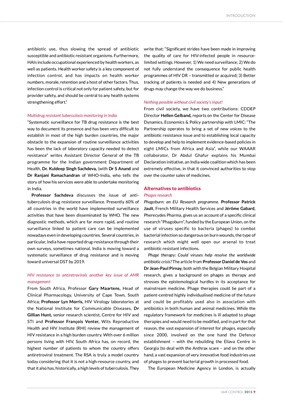
"Reducing unnecessary infections reduces potential
antibiotic use, thus slowing the spread of antibiotic
susceptible and antibiotic resistant organisms. Furthermore,
HAIs include occupational experienced by health workers, as
well as patients. Health worker safety is a key component of
infection control, and has impacts on health worker
numbers, morale, retention and a host of other factors. Thus,
infection control is critical not only for patient safety, but for
provider safety, and should be central to any health systems
strengthening effort."
Professor Sachdeva discusses the issue of antituberculosis
drug resistance surveillance. Presently 60% of
all countries in the world have implemented surveillance
activities that have been disseminated by WHO. The new
diagnostic methods, which are far more rapid, and routine
surveillance linked to patient care can be implemented
nowadays even in developing countries. Several countries, in
particular, India have reported drug-resistance through their
own surveys, sometimes national. India is moving toward a
systematic surveillance of drug resistance and is moving
toward universal DST by 2019.
Multidrug resistant tuberculosis monitoring in India
"Systematic surveillance for TB drug resistance is the best
way to document its presence and has been very difficult to
establish in most of the high burden countries, the major
obstacle to the expansion of routine surveillance activities
has been the lack of laboratory capacity needed to detect
resistance" writes Assistant Director General of the TB
programme for the Indian government Department of
Health, Dr. Kuldeep Singh Sachdeva, (with Dr S Anand and
Dr Ranjani Ramachandran of WHO-India, who tells the
story of how his services were able to undertake monitoring
in India.
HIV resistance to antiretrovirals another key issue of AMR
management
Professor Precious Matsoso, Head of Health Services in
South Africa stresses that, with over 6 million persons living
with HIV, South Africa has, on record, the highest number of
patients to whom the country offers antiretroviral
treatment. The RSA is truly a model country today
considering that it is not a high resource country, and that it
also has, historically, a high load of tuberculosis. She writes
that: "Significant strides have been made in improving the
quality of care for HIV-infected people in resource-limited
settings. However, 1) We need surveillance; 2) We don't fully
understand the consequence for public health programs of
HIV DR - transmitted or acquired; 3) Better tracking of
patients is needed and 4) New generations of drugs may
change the way we do business."
Nothing possible without civil society's input!
From civil society, we have two contributions: CDDEP
Director Hellen Gelband, reports on the Center for Disease
Dynamics, Economics & Policy partnership with LMIC: "The
Partnership operates to bring a set of new voices to the
antibiotic resistance issue and to establishing local capacity
to develop and help to implement evidence-based policies in
eight LMICs from Africa and Asia", while our WAAAR
collaborator, Dr Abdul Ghafur explains his Mumbai
Declaration initiative, an India wide coalition which has been
extremely effective, in that it convinced authorities to stop
over the counter sales of medicines.
Alternatives to antibiotics
Phages research
Phagoburn: an EU Research programme. Professor Patrick
Jault, French Military Health Services and Jérôme Gabard,
Pherecydes Pharma, gives us an account of a specific clinical
research "Phagoburn", funded by the European Union, on the
use of viruses specific to bacteria (phages) to combat
bacterial infection so dangerous on burn wounds, the type of
research which might well open our arsenal to treat
antibiotic resistant infections.
Phage therapy: Could viruses help resolve the worldwide
antibiotic crisis? The article from Professor Daniel de Vos and
Dr Jean-Paul Pirnay, both with the Belgian Military Hospital
research, gives a background on phages as therapy and
stresses the epistemological hurdles in its acceptance for
mainstream medicine. Phage therapies could be part of a
patient-centred highly individualised medicine of the future
and could be profitably used also in association with
antibiotics in both human and animal medicines. While the
regulatory framework for medicines is ill adapted to phage
therapies and would need to be modified, and in part for that
reason, the vast expansion of interest for phages, especially
since 2000, involved on the one hand the Defence
establishment - with the rebuilding the Eliava Centre in
Georgia (to deal with the Anthrax scare - and on the other
hand, a vast expansion of very innovative food industries use
of phages to prevent bacterial growth in processed food.
The European Medicine Agency in London, is actually
planning a meeting on phages and regulatory mechanisms
early June 2015.
Animal Husbandry's role in AMR
Costs and benefits of antimicrobial use in livestock. Could
INTRODUCTION
AMR CONTROL 2015 9